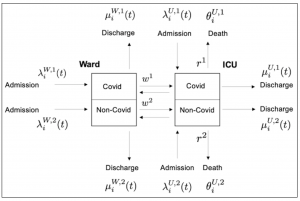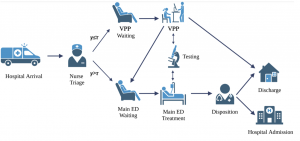Innovators Present Methods to Manage Hospital Emergency Rooms
Philip (Bo) Hammer
The quantification of medical and health care has revolutionized human lives and effected long-lasting social and economic change. This revolution stems from synergies among mathematics, statistics, data science, medicine, machine learning, and artificial intelligence that have prompted new interdisciplinary areas.
For example, the pandemic catalyzed cross-disciplinary work on patient flow through hospital emergency departments among statisticians, operations researchers, actuaries, and AI/ML researchers. COVID transformed how hospitals organize the flow of patients during unexpected extended emergencies that put stress on limited resources such as beds, supplies, and staffing.
The Institute for Mathematical and Statistical Innovation brought together a number of pioneers March 27 to June 2 for a program called Mathematics, Statistics, and Innovation in Medical and Health Care. The aim was to talk about how their work is helping manage busy and overcrowded emergency departments.
Vahid Sarhangian—a statistician at the University of Toronto who spoke during a workshop called Predictive Analytics, Business Modeling, and Optimization in Healthcare Operations Management—examined the admission, flow, and treatment of COVID vs. non-COVID patients. He explained there was a geographic mismatch between demand for hospitalization and hospital capacity during the pandemic and described how high hospital occupancy is statistically associated with worsened health outcomes and higher mortality, adding that there are associated equity issues around these facts.
Sarhangian developed a stochastic control model for flowing patients in and among hospitals that takes into account distances between hospitals and the cost of transferring patients. He proposed a solution for “load balancing” via inter-hospital transfers and tested his model on 3,000 transfers among hospitals in Ontario, Canada.

Stochastic control model for flowing patients in and among hospitals that takes into account distances between hospitals and the cost of transferring patients.
Hospital emergency departments are many times crowded and have long wait times. Predicting wait times is complex because it depends on the number of patients in the emergency department at a given time, which is constantly changing, and triage, which allows a person’s place in line to change if another patient arrives in worse condition.
Georgia Perakis, a professor of management at MIT who specializes in machine learning and operations research, discussed her work using ML to manage triage in a data-driven way that is also equitable during a workshop titled Analytics for Improved Health Care. Complicating factors is that women tend to have longer wait times but not a longer time to discharge, which could negatively affect health outcomes. Perakis hopes her work will make emergency department management more efficient for hospitals while improving health outcomes and the overall experience for patients.

The vertical processing pathway design for the emergency department (ED). The score γ indicates the predicted risk a patient needs an ED bed and is estimated by a machine learning model. The classification threshold τ determines the proportion of patients routed to the VPP unit versus the main ED.
Emergency department overcrowding can lead to undesirable health outcomes such as the patient leaves before being treated, the patient’s condition worsens while they are waiting, or the patient is triaged inequitably. Agni Orfanoudaki, a professor of operations management at the University of Oxford who also spoke during Analytics for Improved Health Care, uses machine learning to improve operational efficiency in the emergency department. Her focus is on nurse-driven “rapid medical assessment,” a strategy to triage patients nearly upon arrival to determine whether they need a bed or can be treated more quickly sitting in a chair. The goal is to discharge everyone who receives a rapid medical assessment and does not need a bed as soon as possible. She uses training data in her ML model to make better predictions about which patients should be prioritized for a bed and which can be quickly treated and discharged.
View the program, videos of the talks, and speakers’ slides.


















Leave your response!